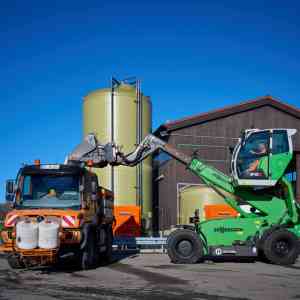LOADING SNOWPLOUGHS TELEHANDLER EQUIPPED WITH A SPECIAL SALT PACKAGE
When winter sets in on the streets of Chemnitz, the Hainichen road maintenance department is well prepared to clear the roads of snow and ice as quickly as possible. Up to 1,200 tonnes of salt can be stored in the road maintenance depot. With the help of the SENNEBOGEN telehandler 340 G, these masses are moved efficiently and safely between the hall, the silos and the winter service vehicles to ensure that the snowploughs are ready for use quickly.
USE OF WET SALT TECHNOLOGY FOR OPTIMUM DE-ICING EFFECT
Next to the hall, there are two more tanks for brine preparation on the premises. The salt from the hall is filled into the brine maker with the telehandler and is processed there. When the tank reaches a certain level, the mixture is pumped into the nearby storage tank. The winter vehicles are filled with brine from the side hoses of the silo. The 340 G, delivered and commissioned by the local SENNEBOGEN dealer Sander Fördertechnik, takes over the loading of the vehicles with the pure dry salt. The road maintenance department works with the so-called wet salt technology FS30 and FS100. With the FS30 technology, brine (in a mixing ratio of 70% salt and 30% brine) is added to the salt shortly before it is applied to the road surface. Compared to conventional dry salt, the wet salt sticks better to the road surface and is less sensitive to scattering losses due to wind drifts. When there is no snow and only ice or frost, the road maintenance department uses the FS100 technology, which is particularly suitable for preventive gritting. In the process, 100% brine is sprayed onto the roadway. The solution remains on the roadway for a longer time and thus retains a longer de-icing effect. In addition, the amount of salt required per use is significantly reduced.
REDUCED PERSONNEL COSTS THANKS TO ELEVATING CAB
The advantages of the machine speak for themselves: In addition to the necessary stability and robustness, the telehandler convinces with its manoeuvrability, especially in the confined spaces inside and outside the hall. A crucial point for the road maintenance department is the elevating cab, which allows an unrestricted view of the tanks and trucks.
“Since we could not see into the tanks with our former wheel loader, an additional person was previously needed to assist and navigate during loading. This tedious process is now eliminated thanks to the elevating cab. In this way, we can save valuable time and costs and increase our safety at the same time“, states the road maintenance department. To be best prepared for working with salt, the machine was equipped with a special salt package. This includes, among other things, the application of a special wax that provides optimal protection against corrosion damage.
Maintainability of the machine
The road maintenance department is also excited about the machine’s ease of maintenance:
“Thanks to the central lubrication, you don’t feel like you have to worry about anything. With our previous wheel loader, we regularly worked with a grease gun – there is a risk that you might forget about that and machine components start to rust as a result. We no longer have this concern with the 340 G.“
Related Post
Go Deep. Convey Smart. The Sandwich...
Tunneling is one of humanity’s oldest engineering practices, dating back to prehistoric times when early humans expanded natural caves for...
Tanco expands liquid barge terminal at...
Tanco Terminals is expanding its liquid barge facility at Ports of Indiana-Jeffersonville to meet rising demand for blended fertilizers in s...
Konecranes at TOC Americas: introducing the...
Konecranes is introducing its Konecranes Noell Hydrogen Fuel Cell Straddle Carrier to the Americas and the world at TOC Americas 2025 in Pan...








Leave us a comment
logged inYou must be to post a comment.